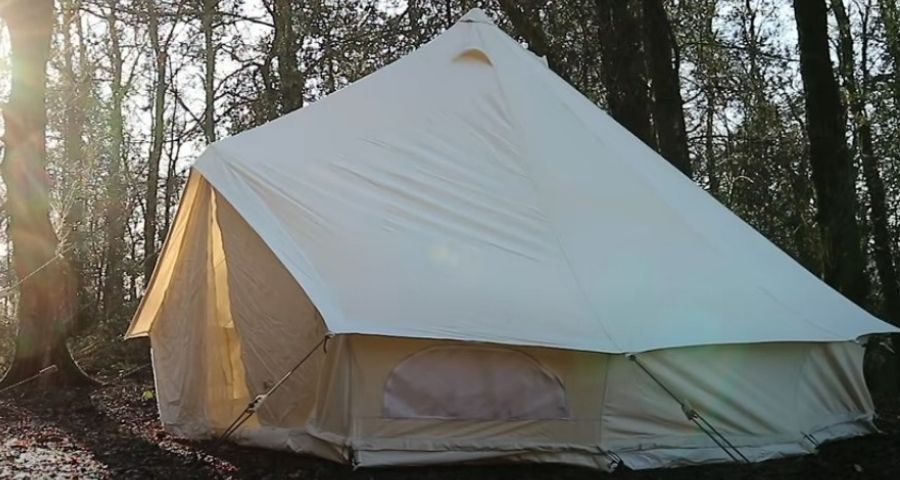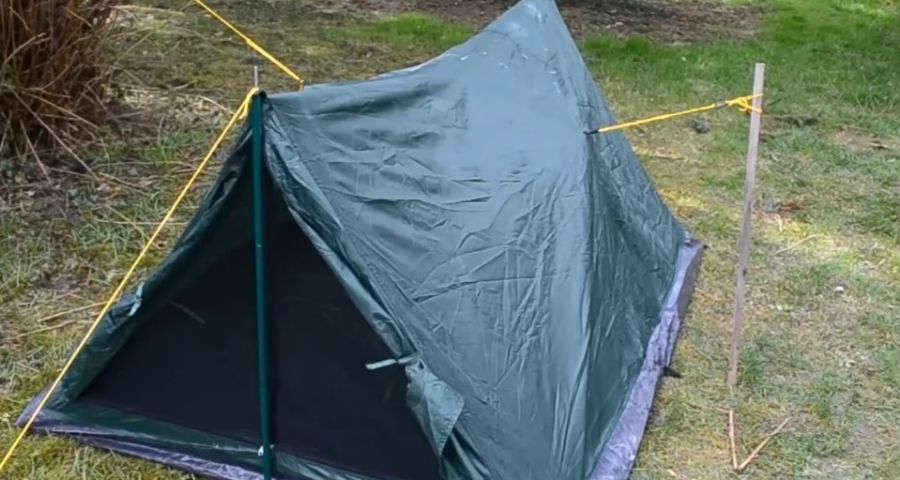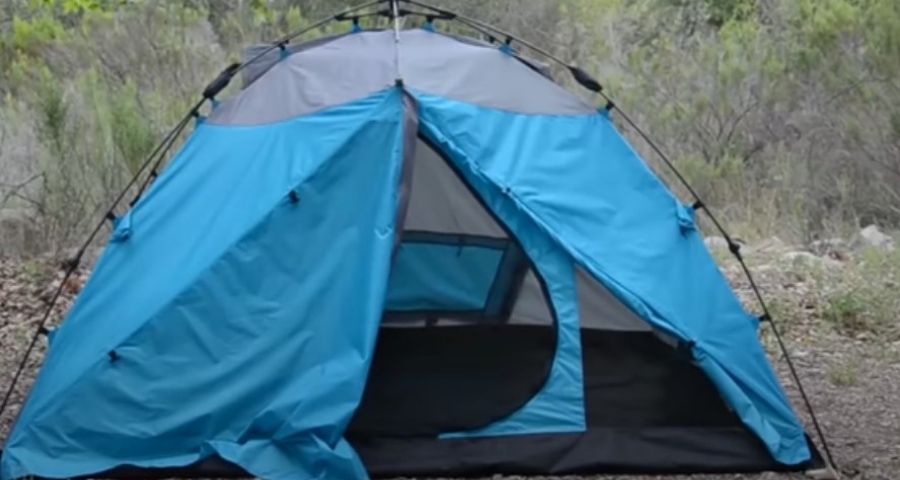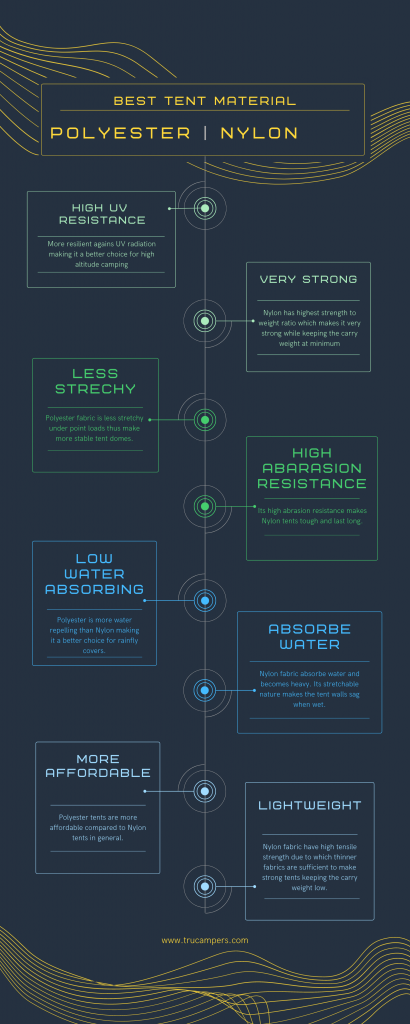In this blog post, you will know about the different tent materials and tent fabrics and their pros & cons so that you can make a better and informed decision before getting your next camping tent.
So, it’s your first time buying a tent. You are browsing different brand websites or probably going through amazon listings trying to figure out which one is the most suitable tent for you. While selecting your perfect tent, the most important factor to consider is the material of the fabric and you might be wondering what materials are tents made of and how they differ from each other. This article is all about tent materials and tent fabrics.
During my initial camping days, I did make some questionable choices that cost me not only money but a few sleepless nights. But I am a little older and a little wiser now and am here to share what I learned over the years.
So, what material are tents made of? The most common tent materials are either natural cotton canvas or manmade fabrics like Nylon 6 or Polyester. Canvas tents are long-lasting, durable, and noise absorbing but heavy and require extra care. Polyester and Nylon tents are strong, lightweight, easy to wash and maintain.
There are not many choices when it comes to selecting your tent fabric. But each one of them is suitable for a particular use case. There is no “best fabric” for all situations so the type of tent largely depends on your use case. Are you going to camp in chilly winter or sunny summer? Do you want a weatherproof tent or just something light and easy to carry?
Choosing an appropriate tent material is usually a compromise between weight, strength, and price. You cannot have them all.
Let’s discuss the commonly used tent fabrics, their properties, pros & cons, and use cases so that you can make a better call while selecting your next camping tent.
What are tents made of?
Although tents are made from many different materials (even some proprietary fabrics), most commercially available tents are made of either cotton canvas, Nylon, or Polyester. Each of these tents serves a specific segment of the camper demographic and is used for specific occasions. Let’s look at them one by one and explore their pros & cons.
Cotton canvas

Cotton canvas tents are either made up of 1×1 plain cotton weave or cotton duck weave. The weave is made by two-ply threads twisted together which adds weights to the fabric.
Canvas is a lot stronger and sturdier than normal cotton or any other fabric because of this special construction. It is designed to withstand harsh weather conditions in the wild and that’s why it is used for long camping trips or temporary offsite living.
Advantages of canvas tent material
Cotton canvas is one of the most durable fabrics. They are widely used for long-term camping and living. They are probably the most widely used temporary living solution and for good reasons.
- Durable and strong: Canvas tents are probably the most durable and strong tent fabric out there. Due to its special weave construction, it can easily last for 10 to 15 years. Cotton canvas also show better abrasion resistance than nylon and polyster.
- Tear Resistant: Canvas tent material is highly resistant to tear. First of all, it is really hard to make a cut in canvas fabric. Even if it does happen, the criss-cross arrangement of the weave prevents the propagation of the tear.
- Water Resistant: The best thing about cotton canvas is its water resistance. Cotton itself isn’t water repellent but has the property of retaining water; once it comes in contact with water, the weave tends to swell due to water retention, which ends up making the tent naturally water-resistant. With a good canvas tent, you don’t often need to put up a tent tarp for extra protection. The tent does all the heavy lifting.
- Highly Insulating: Canvas is quite popular due to its power of insulation. Due to its heavey weave, cotten tends to stop noise, heat and wind making the inside of the tent very cozy and safe. Canvas tents are also easy to keep warm in winters.
- Low Heat Retention: Cotton also has low heat retention properties, which helps this fabric to stay cool in summers.
Disadvantages of canvas tents
You must be thinking “this is it. I am getting a cotton canvas tent”. But before you jump the guns, also consider some of the disadvantages of cotton canvas fabric.
- One of the major disadvantages of a cotton canvas tent is its heavy weight. It requires 2-3 campers to pitch a wall or bell canvas tent. For backpackers, its almost impractical to carry.
- With heavy weight comes heavy poles to keep it upright. This makes the canvas tent impractical for backpackers and light travellers.
- Being a natural fabric, the canvas is also prone to mold and mildew, it is a lot more difficult to take care of a cotton tent than any other tent.
- Cotton also tends to change colors in extreme temperatures. Excessive exposure to heat, oil or dust may cause your tent to turn yellow. I have ruined a perfect canvas tarp by using it to cover my parked RV during an off-season. The same can happen to your canvas tent if not maintained properly.
- Cotton canvas tents are also very pricy compared to other more budget friendly tents. If you are occasional camper, this might not be a good value for money.
TETON makes great canvas tents if you are looking for a multi-person space. Their prices are a little high ($500+) but totally worth it. Check their latest pricing on Amazon (Link: TETON Sports Family Tent)
Nylon 6 and Nylon 6/6

Nylon is a synthetic thermoplastic polymer fabric made from petroleum byproducts. First developed by DuPont in the 1930s, Nylon has found applications in many areas including camping tent fabric. It is one of the most popular fabrics used in tents these days.
Since it is a synthetic polymer compound, it is made with different molecular configurations which result in different types. Among them, the Nylon 66 (also designated as Nylon 6.6, Nylon 6/6 or Nylon 6:6) and Nylon 6 are widely used as tent fabric.
These tents are also very affordable and are preferred by regular campers who keep moving from one place to other during their trip.
Advantages of Nylon tents
Commercially, Nylon is the uncrowned king of tent material due to its many friendly properties. Here are the most important ones.
- Strength to Weight Ratio: If you are going to look at the strength of fabric, you have to consider its weight as well. Canvas, as discussed above, is strong but it is also very heavy. The strength to weight ratio is a good indicator of how much strong a fabric is without it getting to heavy. Nylon has very high strength to weigth ratio compared to other tent fabrics like polyester and canvas. That means, its pretty strong while being lightwweight.
- Stretchability: Nylon stretches. While you might think “so what?” its pretty important. When a material stretches under load, it distributes the presssure over a larger surface area hence reducing the probabiliy of failure at the point of load. Combine this with its high strength, Nylon becomes pretty much a badass tent material option.
- Abarasion Resistant: Nylon also has high degree of abarasion resistance. If a material abarase when rubbed against a harder surface (ground, sand particles in high speed wind etc.) its surface loses its strength and can fail eventually. Nylon being a highly abbrasion reistant can withstand any abbrasive force in the wilderness.
- Lightweight & portable: Due to its higher strength to weight ration, enough tensile strength can be packed into a thin fabric layer making Nylon tents very lightweight and hence portable. They also do not require stronger heavier support structure (poles, guylines, pegs etc).
- Low maintenance: Nylon tents are very low maintenace compared to Canvas fabric. They do not develop mold and mildew and are good for camping in damp areas for longer period. Also, you can store them during an off-season without any special care. Nylon tents are also very easy to wash.
Disadvantages of Nylon tents
Here are some of the drawbacks of Nylon tents that might make them unfit for certain conditions.
- Water absorbing: Nylon fabric are not inherently waterproof or even water resistant. They absorbe water during a rainy night and become saggy and heavy. Since they are flexible, the extra weight of the water sags the tent walls. This can be mitigated by waterproofing your tent to some extent.
- UV Degradation: Nylon is prone to UV radiation (more than polyster) and will degrade over time if exposed consistently. If you are going to camp at high altitudes, this might be a problem as UV exposure is considerably high at higher altitudes. A suitable UV protection spray should reduce the long term exposure.
- Less breatheable: Compared to cotton canvas, nylon is also less breathable and has a low condensation rate. The beatheability further decreases if you apply waterproof coating to the outside of the tent.
Product Recommendation: If you are under budget, I would recommend Coleman Sundome Series. But for a more sturdy tent, I would recommend Big Agnes line or Marmont.
Polyester

Although Nylon has been used for tents more often, polyester tents are finding their way into the market as well. They offer some distinct properties that make them a viable alternative to Nylon tents.
Properties of Polyester tents
Less stretchable & more stable: Polyester is less stretchable compared to Nylon. Although this makes Polyester tents more prone to ruptures under point loads, it also makes the poly tents more stable. They maintain their shape during wind and rainfall.
Tear Resistant: Polyester tents have good tensile strength and are not prone to tear easily. Although compared to the same weight of Nylon fabric they are less strong but a slightly thicker weave can easily match Nylon’s strength.
Water-Repelling: Polyester weaves are more water repellent compared to Nylon. Due to this, they make better tents for rainy campsites. Since they do not absorb water, they don’t get heavy and saggy (they are also not stretchy so they maintain shape even under wet conditions)
UV Resistant: My favorite plus of Polyester tents is their superior UV radiation resistance. Compared to Nylon, they don’t degrade very quickly under high exposure. Due to this (and their superior water resistance), they are often used for rainfly fabric in high-altitude tents with canopy fabric made out of Nylon.
Product Recommendation: If you are planning a short-term camping trip and need a lightweight, easy-to-carry solution, check out Big Agnes polyester tents.

Tent material selection table
Comparison between cotton polyester and nylon is pretty obvious, as polyester and nylon have almost similar properties, and cotton doesn’t possess them.
If you still can’t decide which tent to get, then this table might give you a subjective overview based on my own experience as a textile engineer who has worked for 2 years for a company that makes tents and other camping equipment.
| Properties | Canvas Tent | Polyester Tent | Nylon tent |
|---|---|---|---|
| Breathability | ++++ | ++ | ++ |
| UV Resistance | ++ | +++++ | +++ |
| Portability | ++ | ++++ | +++++ |
| Quick Drying | + | ++++ | +++ |
| Tear Resistance | +++++ | +++ | ++++ |
| Susceptible to shrinkage | +++++ | + | + |
| Long term use | +++++ | ++ | +++ |
| Stretchability | +++ | ++ | +++++ |
| Inherent water resistance | +++++ | ++++ | +++ |
| Abrasion Resistance | +++++ | +++ | ++++ |
| Require Maintenance | +++++ | + | + |
Best tent material for cold weather
As we discussed at the start of the article, selecting a suitable tent fabric boils down to its use case. For cold and harsh weather, you need a sturdy, strong construction that can offer maximum protection against cold breezes, snow, rain, and strong winds.
If you are camping out of your truck or car, a cotton canvas tent is your best option. Although it is a challenge to carry it to and from the car/truck and setting it up, it’s worth the extra effort. Especially if you are camping for a longer period in a fix location, you will definitely appreciate the coziness of the warm cotton canvas.
However, if you are backpacking, hiking, or trekking and need something that doesn’t weigh you down, go for a Nylon tent. It provides enough protection against gusty winds. Do not forget to waterproof your tent because Nylon is not naturally waterproof.
Best tent material for hot weather
For hot and sunny weather, you need a place to crash after a long hike. Both Nylon and Polyester tents are perfect for summer camping. They are lightweight, easy to carry, and easy to set up – something that you would want during hot and tiring summer evenings.
Polyester tents provide slightly better breathability compared to Nylon. Apart from that, the specific tent you buy should have screen mesh for proper ventilation. Coleman uses specific colors to block up to 90% of sunlight in its tents and calls it ‘darkroom technology’. This also results in 10% reduced cabin temperature compared to the outside which is ideal for summers.
Best tent material for backpacking
For backpacking when your backpack weight is an ultimate concern, I would definitely suggest going with Nylon tents due to their lower packing weight. As most backpackers travel during the summers, Nylon tents are an obvious choice.
Tent Materials – FAQs
What is a ripstop fabric?
Ripstop fabric is a special type of fabric that resists tears or rips by utilizing a special reinforcing technique by crisscrossing the yarn at regular intervals. The crisscross arrangement stops the ‘rip’ from propagating and makes it tear-resistant. Both Polyester and Nylon come with ripstop fabric.
What is Dyneema or Cuben Fabric?
Dyneema or Cubin is the new non-woven material being used in tents. They are made up of polyethylene of high molecular weight. These fabrics are pretty lightweight and provide better tear and abrasion resistance than nylon and polyester. But, these fabrics are not very affordable and do not provide good stretchability.
Are cotton tents waterproof?
Yes. Cotton tents are waterproof. Cotton is not naturally water repellent but once it absorbs enough water, the cotton threads swell and restrict further penetration of water thus making it practically waterproof.
What are the effects of finishes on fabric?
Tent fabrics are usually coated with a waterproof and non-flammable coating to save them from rains and fire in the wilderness. These coatings may affect fabric breathability and strength to some extent. Also, finished fabrics require much more care than non-coated fabrics as the finishes tend to come off during heavy rains or UV exposure.
What are waterproof tents made of?
Waterproof tents are either Polyester or Nylon but are coated with a waterproofing layer. This can be silicon-based or PU coating that seals the pores and prevent water from seeping in. Some materials like Dyneema or inherently waterproof and don’t need any coating.
Tents fabric material – Conclusion
No matter which fabric you go with, you will end up finding both negative and positives in it.
It is all about planning your trip and determining factors like how long the stay will last? Where do you want to camp? is the campsite dry and hot or cold and damp? Is plastic something that suits you, or do you want a natural insulated environment to sleep in?
If you find answers to all of these questions, you’ll know exactly which one to get.
Additional Read: Air Mattress Alternatives for Camping
Recommended Camping Gears: I have compiled a list of my favourite camping gear in one place. The selection is based on my own personal experience using them for many years camping as well as feedback from fellow campers. Check them out on my Recommended Camping Gears page